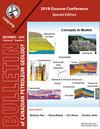巴芬湾/拉布拉多海石油勘探开发地球科学新贡献
Q3 Earth and Planetary Sciences
引用次数: 3
摘要
巴芬湾和拉布拉多海涵盖了一个广阔的海洋区域,横跨加拿大和格陵兰岛的国际管辖范围(图1)。这些海洋体总面积超过150万平方公里,它们被以长峡湾和深水道为特征的广阔而地理复杂的海岸线所包围。冬季,巴芬湾的大部分地区会形成海冰,而夏季,从格陵兰冰盖下降的冰川产生的冰山会对整个海洋地区造成持续的威胁。虽然周围的海岸线多为险峻,但在这些海相盆地中存在着相当大范围的大陆架,其特征是碎屑地层的堆积,主要是中生代晚期至新生代。最近对该地区石油潜力的评估表明,巴芬湾可能拥有1555亿桶石油和9.3万亿立方英尺天然气(Gautier等人,2011),而拉布拉多海的大陆架地区可能拥有4.2万亿立方英尺天然气和1.23亿桶石油的可采资源(纽芬兰和拉布拉多政府,2000)。图1巴芬湾/拉布拉多海地区地图,显示特刊投稿的主要地理特征和重点领域。比洛特岛;迪斯科岛。虽然拉布拉多海岸的中新生代地层的陆上暴露极为罕见,但在Nuussuaq半岛和Disko岛的巴芬湾地区以及西格陵兰岛的邻近地区,以及Bylot岛和努纳武特东北部的邻近地区,都发现了显著的陆上序列。这些层序提供了可接近的露头,作为保存在近海的地层序列的类似物。虽然最近对格陵兰岛的演替进行了广泛的研究,并建立了这些岩石的综合岩性和生物地层学框架(Dam等人,2009年),但对巴芬湾加拿大一侧的类似研究是在20世纪70年代进行的。同样,一些……本文章由计算机程序翻译,如有差异,请以英文原文为准。
New contributions in Baffin Bay/Labrador Sea petroleum exploration and development geoscience
Baffin Bay and Labrador Sea encompass a vast marine region straddling the international jurisdictions of Canada and Greenland (Fig. 1). Together, these marine bodies encompass more than 1 500 000 km2 and they are bounded by a vast and geographically-complicated shoreline characterized by long fiords and deep channels. Sea-ice forms in much of Baffin Bay in winter, while icebergs originating from glaciers descending from the Greenland icecap create a constant hazard across the marine region during summer. Although much of the surrounding coastline is precipitous, a significant extent of continental shelf is present in these marine basins, characterized by accumulations of clastic strata, principally of late Mesozoic to Cenozoic age. Recent assessments of petroleum potential of the region have suggested that Baffin Bay may hold 1555 MMbbl of oil and 9.3 TCF of gas (Gautier et al., 2011), while shelf areas of the Labrador Sea may contain recoverable resources of 4.2 TCF of natural gas and 123 MMbbl of oil (Government of Newfoundland and Labrador, 2000).
Figure 1
Map of Baffin Bay/Labrador Sea region showing principal geographic features and areas of focus of the contributions in the Special Issue. BI = Bylot Island; DI = Disko Island.
While onshore exposures of Mesozoic-Cenozoic strata are extremely rare along the Labrador coast, significant onshore successions are found in the Baffin Bay region on Nuussuaq Peninsula and Disko Island and adjacent areas of West Greenland, and on Bylot Island and adjacent areas of northeast Nunavut. These successions provide accessible outcrops that serve as analogues for stratigraphic sequences preserved in the offshore. While extensive study of the Greenland succession has been undertaken recently, and a comprehensive litho- and biostratigraphic framework for these rocks established (Dam et al., 2009), similar studies of the Canadian side of the Baffin Bay are vintage 1970s. As well, some …
求助全文
通过发布文献求助,成功后即可免费获取论文全文。
去求助
来源期刊

Bullentin of Canadian Petroleum Geology
Earth and Planetary Sciences-Geochemistry and Petrology
CiteScore
2.50
自引率
0.00%
发文量
0
期刊介绍:
The Bulletin of Canadian Petroleum Geology is a peer-reviewed scientific journal published four times a year. Founded in 1953, the BCPG aims to be the journal of record for papers dealing with all aspects of petroleum geology, broadly conceived, with a particularly (though not exclusively) Canadian focus. International submissions are encouraged, especially where a connection can be made to Canadian examples.
 求助内容:
求助内容: 应助结果提醒方式:
应助结果提醒方式:


